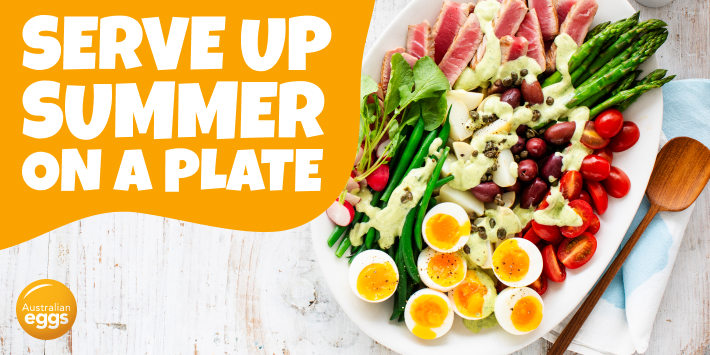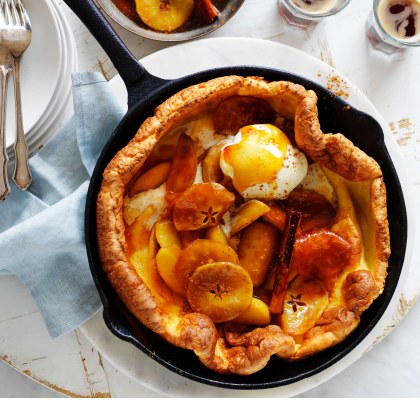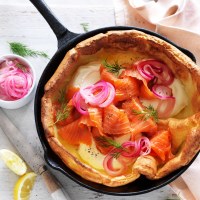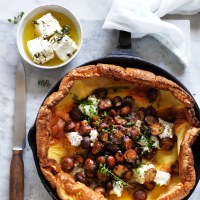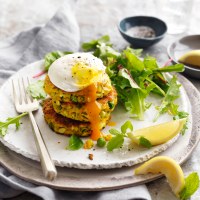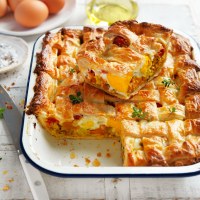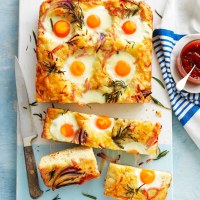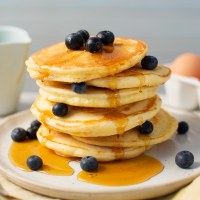How to make a Dutch Baby pancake
A well-made Dutch Baby pancake - also known as a German pancake - is a magical thing. The thin batter puffs up in the oven, turning golden and crisp around the edges with a soft, fluffy centre. Once you know the simple technique, making them is a breeze and you can enjoy them over and over.
Here’s how to make a Dutch Baby pancake from scratch, with FAQs and topping ideas. Special thanks to the team at Australian Eggs for sharing this masterclass series.
Dutch Baby pancake ingredients
- ⅔ cup (100g) plain flour
- 1 tsp salt
- ⅔ cup (160ml) milk
- 3 eggs
- 30g butter, diced
Method
- Arrange one oven rack in the middle position and remove all other racks above or below. Set oven to 240°C/220°C (fan-forced) and place a 25cm (top measurement) ovenproof frying pan into oven to heat up.
- Combine flour and salt in a large mixing bowl and make a well in the centre. Pour in milk and add eggs. Whisk to a smooth batter and let rest for 10 minutes.
- Once oven has reached temperature, remove hot frying pan from oven using oven mitts. Close oven to retain heat. Working quickly to reduce heat loss, add butter to pan (diced butter will melt easily and quickly) and swirl to coat all the base and sides. Pour in batter and return to oven. Cook 15-18 minutes or until pancake has puffed up and sides are golden.
Watch how to make a Dutch Baby
Get the recipes from Australian Eggs and save them in your myfoodbook cookbook here:
Do you need a cast iron pan for Dutch Baby pancakes?
Nope! Cast iron pans work best, but all you need is a good-sized pan that’s resistant to high oven temps. Stainless steel works well too, but non-stick pans don’t as most aren’t resistant to very high temperatures.
Where to place your Dutch Baby in the oven
Arrange oven shelves so that the shelf is in the lower part of the oven. Remove any top shelves because your Dutch Baby will rise significantly, and there’s nothing worse than pancake batter on the underside of your oven racks.
The best way to preheat your pan
Place the pan inside the oven before you turn it on, so it will heat slowly with the oven. When the oven reaches temperature, you’ll know your pan is totally saturated with heat.
Do you need a blender for Dutch Babies?
No, you can use a blender, food processor or simply whisk the batter with a fork or balloon whisk. Aim for a lump-free batter.
Do you need to rest Dutch Baby pancake batter?
No, it’s not completely necessary. However, resting it for 10 minutes or more allows the flour to hydrate and can help you achieve a smooth batter.
Can Dutch baby pancake batter be made the day ahead?
Yes! The batter can be made ahead and refrigerated overnight. Remove from fridge about 20 minutes before using to take the chill off.
How long does it take to cook a Dutch Baby?
It can take between 12-18 minutes to cook. Start checking after 12 minutes, as every oven is different and cooking times can vary dramatically.
Taking your Dutch Baby out of the oven
The pan will be especially hot, so use thick, dry oven mitts or cloths and have a heat-resistant place ready to put it. Leave a mitt or tea towel on the handle as a reminder that it’s hot. Don’t use damp cloths or mitts, as they’ll conduct heat and burn your hands!
How do you eat a Dutch Baby?
Top it with one of the topping ideas below and serve it as soon as possible, as it will deflate. Cut it into wedges and serve from the pan (being careful not to burn yourself) on large plates with extra toppings. Depending on what you fill your Dutch Baby with, you can use a knife and fork, or simply use your hands to roll and eat.
Now you know all the tips and tricks, you’ll be a Dutch Baby master in no time. Check out topping ideas below!

